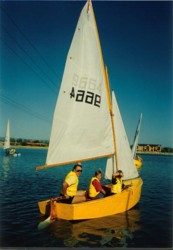 Learning to sail in a Heron, West Lakes, South Australia | |
| Boat | |
|---|---|
| Crew | 2 (max) |
| Hull | |
| Hull weight | 63.7 kg (140 lb) |
| LOA | 3.429 m (11.25 ft) |
| Beam | 1.372 m (4 ft 6.0 in) |
| Sails | |
| Mainsail area | 4.78 m2 (51.5 sq ft) |
| Jib/genoa area | Jib: 1.72 m2 (18.5 sq ft) Genoa: 2.83 m2 (30.5 sq ft) |
| Spinnaker area | 6.36 m2 (68.5 sq ft) |
| Racing | |
| D-PN | 120.0 |
| RYA PN | 1346 |
The Heron Dinghy is a dinghy designed by Jack Holt of the United Kingdom as the Yachting World Cartopper (YW Cartopper). The Heron dinghy was designed to be built by a home handyman out of marine ply over a timber frame, but can now also be constructed from marine ply using a stitch and glue technique or from fibreglass. Modern dinghies will usually have built in buoyancy tanks; older craft will have bags or retrofitted tanks.
Since about 1980 boats have been increasingly made of fibreglass, although the Australian association has approved stitch and glue construction .
The Heron is sailed in the UK and Australia and New Zealand, with a few others spread around the world. UK class rules vary slightly from the Australian Rules.[ how? ] In the UK a spinnaker is permitted and a larger genoa can be used. The UK also permits the use of different rudder shapes and a Bermudan Mast. Other more minor differences exist between the rules. [1] The Heron cartop dinghy was popular in Ireland from the late 1950s until the arrival of the Mirror which was lighter, easier to build, and had built in buoyancy. [2]
They are mainly used as adult/child racing dinghies.[ citation needed ] For state and national titles the Olympic triangle course is often used.[ citation needed ]
The Heron has a Portsmouth Yardstick of 1346 when sailed single handed. [3] In the US Sailing scheme it has a D-PN of 120.0. [4]
Over 10,500 Heron sail numbers have been issued since the design first appeared in the late 1950s. [5]
The first Heron, No 1 Flook, still exists and is now owned by the National Maritime Museum Cornwall. [6]